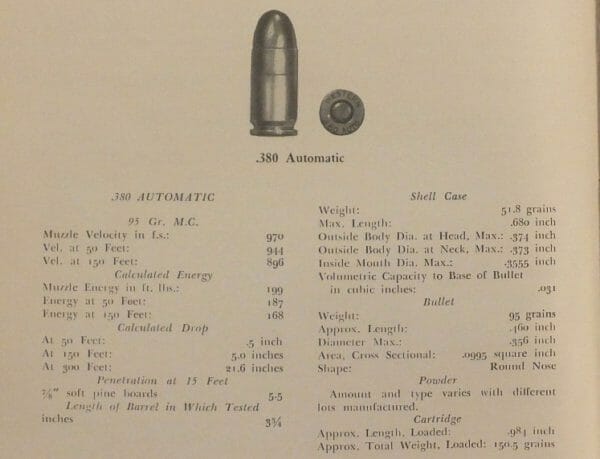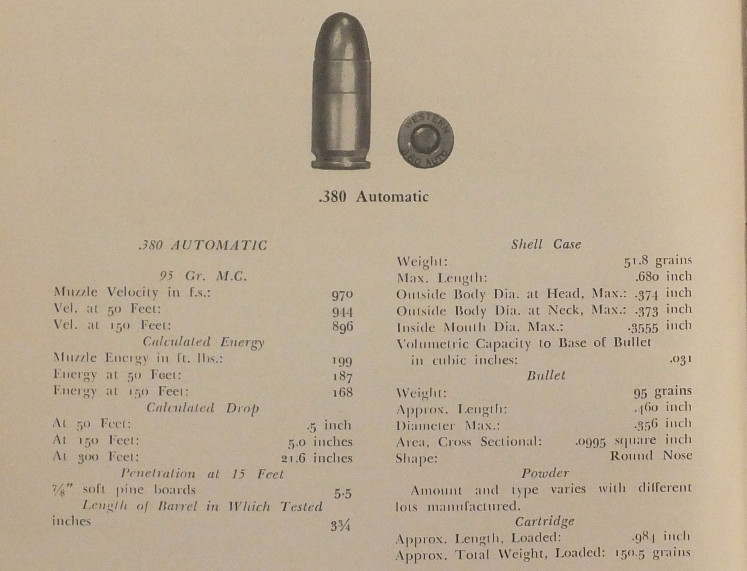
U.S.A. –-(AmmoLand.com)-– Before electronic chronographs became common, or ballistic gelatin was thought of, a standard for bullet penetration was the number of 7/8″ soft pine boards, spaced an inch or so apart, which the bullets would penetrate.
In Pistols & Revolvers, Volume One of the N.R.A. Book of Small Arms, published in 1946, penetration of pistol and revolver cartridges are given in the number of 7/8″ pine boards the specific round would penetrate. Soft pine is not an easy standard to replicate. Trees grown in different areas have different densities, as do different species. The age of the wood can make a difference. Ballistic gelatin does a better job of measuring bullet expansion, for expanding bullets.
If you wish to measure penetration, one of the author’s colleagues and a source for several bear defensive incidents, has offered an inexpensive solution. Due to privacy concerns, he wishes to be known as Old N Bold. He has experimented extensively, using inexpensive sheetrock as a consistent medium to measure bullet penetration. The author has lightly edited his comments.
Here are his comments and the experimental results of his ballistic sheetrock penetration tests:
By OLD N BOLD
Many have questioned the effectiveness of various handgun calibers and bullets for bear defense. Years ago the US fish and Wildlife quote was 50% success for handguns. Tom Smiths and Steven Herrero’s 37 pistol uses against bears said 84%, including cases where the handgun was not fired. Dean Weingarten’s records/statistics reveal a much higher success rate when the handgun was fired. Now that Dean’s numbers far exceed the hundred mark (123) let there be no doubt.
Why can a pistol bullet with modest velocity and muzzle energy get the job done? The answer is simple. PENETRATION. Whether it be to the vitals, brain or other central nervous system non-expanding pistol bullets of 9 MM and up are up to the task. Especially heavy for caliber Hard Cast, Full Metal Jackets, and Monolithic bullets.
It is not an absolute necessity to have solid type bullets. It’s a good idea to have a bullet capable of penetrating over 20-24 inches fur/hide, meat and fat etc. 30″ or more is better yet. A bullet may be required to go through 15 inches of fat ( an actual necropsy ) before reaching vital areas. Most law enforcement loads penetrate 12″-16″ with 18″ maximum in 10% ordinance calibrated gelatin. Self defense loads may penetrate as little as 9″. Hollow Point bullets or other shallow penetrating bullets are going to fail to go deep enough some of the time. Hard cast and full metal jacked bullets have been the key to hitting a bears spine deep within a bears body causing full or partial immobilization in a number of cases.
Old ‘N Bold has been testing bullets/buckshot/shotgun pellets for over 60 years. Gelatin, meat/muscle, bone, water, milk jugs, wet pack, dry books, auto glass, car doors, various steel, 1 1/4″ layered tempered glass, high security lexan of various thicknesses, 1 3/4″ of high security Lexan/glass laminates, cadaver’s, sheet rock, plywood, logs, and more. Tests number over 1200.
After reading numerous articles by or about Dr. Martin Fackler, Walter D. Bell (Karmamojo Bell) a man who killed over a thousand elephants with a 7 X 57 Mauser ( 275 Rigby ) and 200 with a 6.5 X 54, Stopping Power by Evan Marshall and Ed Sanow -15,000 actual shootings eventually analyzed, and FBI ballistics reports, reveal SHOT PLACEMENT is the number one deciding factor, not necessarily the largest bullet, that stops man or animal quickly.
Todd Orr has killed at least 29 elk with hard cast bullets in .44 mag and one with a 10MM. He says these bullets slightly deform or mushroom , and penetrate to the far side of an elk. He got mauled twice by a grizzly in one day. He carries a scoped .44 mag AND a 10MM auto when hunting elk now. Todd is a MAN with experience.
Testing is useful to determine bullet performance, but gelatin is expensive. 16″ gelatin blocks may cost $179 apiece. It would cost over $2000 to do the tests I do for less than $50. 40 years ago I discovered 4 half inch layers of sheet rock equaled the penetration of 8 inches of thawed deer meat. Blemished sheet rock can be bought for half price or found free at construction sites. It is reasonably consistent and temperature insensitive. It works great for non-expanding bullets. I use it because it is easy to set up on a homemade table using scrap lumber with vertical supports for the sheet rock. Use a tarp underneath to keep a clean range. Bungy cord about 25 layers of sheet rock together. 10 “X 16″ or 10″ X 24” sheets work well. 3-5 shots can be evaluated for each stack.
Each 5/8″ layer of sheet rock MAY BE roughly equivalent to 2 inches of calibrated 10% gelatin. This is roughly equivalent to 1.3-1.75 inches of animal. You decide. It isn’t real meat, but neither is gelatin. The consistency of sheet rock means you can compare one pistol, caliber, or bullet to another. I do this because different manufactures have provided a wide variety of claims for similar bullets with similar velocities. Reputable sources have 9MM 115 gr. FMJ bullets going through 22.1 inches of gel. and 124 gr. FMJ bullets up to 32″. I had a box of 10MM ammo marked 1250 feet per second on the box while a chronograph said 1038-1042 FPS.
For a baseline:
- 9MM 124 FMJ 1200 FPS NATO, penetrates 32″ of 10% gelatin. Source: Martin Fackler.
- GI Ball .45 auto 230 gr. FMJ penetrates 25-27″ of gelatin. Source: Stopping Power by Ed Sanow Evan Marshall.
- 12 ga. 1 ounce Hollow Point Foster Type slugs 12-18 inches. 1 oz. Brenneke slugs 34″. Source: Brenneke technician. Note: Brenneke slugs are used by Alaska State Troopers.
Old N Bold results in 2020, penetration in the number of 5/8 inch sheetrock sheets. Multiply by 2 for rough equivalent in ballistic gelatin:
- .22 pistol 4″ BBL 40 gr. Federal 2 types; 9 & 9 sheets
- 9MM Glock 17 115gr. FMJ Browning 1180 FPS on box; 15 sheets
- 9MM Glock 17 Winchester 124 NATO FMJ; 16 sheets
- 9MM Glock 26 3.5 BBL 147gr. Blazer Brass; 15 sheets
- 9MM Buffalo Bore 147gr. +P Hard Cast (Killed One Grizzly, Killed one Brown Bear) 17-18 sheets ESTIMATED. Factory claimed penetration 46″ gelatin
- 9MM Underwood 147gr. FMJ +P+ two rounds; one bullet tumbled; one 17 or 18 sheets; one 19.5 sheets
- .40 Glock 22 Winchester 180 FMJ; 15.5 sheets
- .40 G22 Buffalo Bore 200gr. Hard Cast. This bullet tumbled Factory claimed 48″ + in gel.; 15 sheets
- .40 G22 Underwood 200gr. Hard Cast Large Flat Nosed (MePlate); 16.5 sheets
- 10MM G20 Sig 180 FMJ; 19 sheets
- 10MM G20 Underwood 200 gr. Hard Cast Large flat nosed; 19 sheets
- .44 Mag. 6″ BBL 19gr. 2400 powder, 95% load 255gr. Hard cast Keith Style Bullet; 22 sheets
- .45 Auto 4.4 BBL Win. and Rem. 230gr. FMJ; 11-11.5 sheets
While in the field or fishing, including Alaska, I find many people carry nothing. Of those that carry, over half carry 9MM’s, some .40’s and a few 45 Autos. Big guns are seldom seen.
I suggest everyone look up Buffalo Bore Ammunition. At the site, find Technical Articles. In the technical articles, read Trail and Camp Guns. Then read Stopping Bears with Handguns or Rifle Cartridges, both written by Tim Sundles.
Tim Sundles shot his first bear at age 13 with a heavy .38 Special load. Tim likes big bore pistols for Grizzly/Brown bears, moose, and bison.
Here is an interesting discussion about bear spray:
Bear Spray at a glance by Gus C.
- 1. Easier to aim and statistically more reliable.
- 2. Expert aim and nerves of steel needed for successful firearm defense.
Comment by Mel R. 7-14-2018. Sprayed bear at 15 feet. I enveloped the bear in a cloud of bear spray mist. The bear ignored it.
LMJ: in the last 5 years deaths verified in several cases due to bear spray failure. Show us a death where a bear was hit by a handgun bullet and the person died in the last 5 years.
– end of Old N Bold comments –
About Dean Weingarten:
Dean Weingarten has been a peace officer, a military officer, was on the University of Wisconsin Pistol Team for four years, and was first certified to teach firearms safety in 1973. He taught the Arizona concealed carry course for fifteen years until the goal of Constitutional Carry was attained. He has degrees in meteorology and mining engineering, and retired from the Department of Defense after a 30 year career in Army Research, Development, Testing, and Evaluation.







With the emphasis on penetration, I got to wondering about the effectiveness of the 7.62×25 Tokarev round. This was the dreaded “cop killer” round of the 90s that was able to penetrate ballistic vests. Kind of a jacked up version of the new 30 Super. I realize it is a small pill, but if the point is to penetrate to the brain of a bear…
Having shot shot deer, bears, and hogs with several different handgun rounds.
Shot placement and good penetration is the key to success.
I prefer handguns with velocities over 1000fps with heavy for caliber bullets for big game.
Well others work yes. It is just some are more reliable then others in getting the job done.
5.5 inch Redhawk .in .45 Colt, loaded with Double Tap 255 grain hardcast +p.
When one has access and can shoot reasonable well with a good firearm winning the fight with a bear isn’t that difficult.
Bears are not that hard to kill.